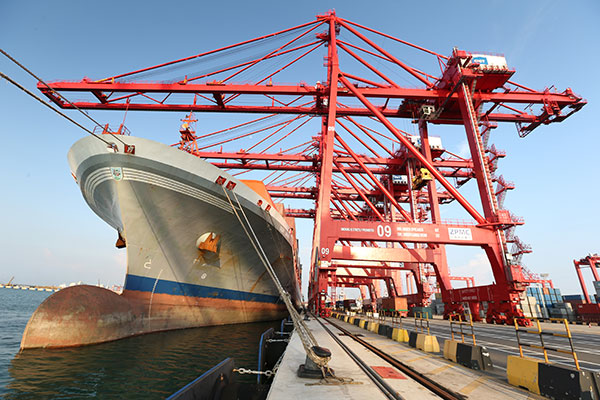
After Premier Li Keqiang delivered his annual Government Work Report, Wojciech Jakobiec, first secretary of the Polish embassy in Beijing, said he was particularly happy to hear repeatedly references to ongoing Chinese initiatives to revive and modernize the ancient Silk Road trading routes.

Workers load goods onto a container ship in Colombo, the capital of Sri Lanka, where a port development project has been part of Beijing’s efforts to create a Maritime Silk Road.[Xinhua]
“For us, the Silk Road Economic Belt is an especially important project, and we would like to participate in it,” said Jakobiec.
Along with his embassy colleagues, Jakobiec was among a host of foreign diplomats who gathered at the Great Hall of the People on March 5 to hear Li’s speech and glean hints on the future direction of Chinese development and diplomacy, which will have a huge global influence in the coming decade and beyond.
At a media briefing on March 9, Foreign Minister Wang Yi said this year China’s diplomats will focus on making all-around progress in the Silk Road Economic Belt and the 21st Century Maritime Silk Road initiatives. The priorities will to be the promotion of connectivity, and the construction of overland economic corridors and pillars of maritime cooperation. “We are confident that Belt and Road initiatives will win even more support and deliver even more early harvests,” Wang said.

A businessman takes a photo of handicrafts in Yiwu, Zhejiang province. Yiwu is one of China’s “boom cities” and is expected to play a big role in the Silk Road Economic Belt.[Xinhua]
The “new Silk Road” initiatives, networks that will connect China with Europe via a host of Asian economies, have been hot topics at the ongoing meetings of China’s top national legislative and consultative bodies, and have also served as flagship projects for Chinese diplomats, who have sought to highlight shared regional interests and reduce confrontation.
Opinion has been mixed, though. Some observers said the recent slew of proposals, especially those related to economic issues, will forge stronger bonds between China, the world’s second-largest economy, and the other nations, and reinforce China’s standing as a responsible global power.
Other shave warned that the ambitious strategy will take many years to become a reality, and that the potential for derailment exists over the long term, despite the remarkable progress been made since President Xi Jinping first out-lined the project less than two years ago.
Shared interests
Gao Hucheng, minister of commerce, said 2015 will be a critical year for the Silk Road Economic Belt and the 21st Century Maritime Silk Road initiatives, and the ground is being prepared. China is negotiating with countries along the route and some parts of the overland project are now being implemented, while others remain at the planning stage, he said during the weekend.
More than 50 countries along the ancient trading route have expressed a willingness to participate in the initiatives, which were bolstered last year by the founding of the Silk Road Fund and the Asian Infrastructure Investment Bank, which should improve connectivity and provide a wider range of public services for the people of the region.
Major General Yang Yi, a former researcher at the National Defense University of the People’s Liberation Army, said the initiatives serve both the domestic and diplomatic agendas, especially in terms of economics: “The mutual interdependence between China and the rest of the world is unprecedented, and a rapidly developing China needs its own plans to realize its national development goals and take the diplomatic initiative.”
The proposals to establish a modern-day Silk Road were driven by China’s huge outbound investment, and came amid a massive drive to upgrade the infrastructure in the developing world.
According to the Asian Development Bank, the region will require as much as $730 billion per year in infrastructure investment by 2020, and last year Xi confirmed that China’s outbound investment will exceed $1.25 trillion over the next decade.
Li Haidong, a professor of US Studies at the China Foreign Affairs University, said China’s outbound investments to countries along the Silk Road could help to maintain growth as the economy transitions from being driven by exports and investment. The region’s potential is there to be tapped, he said.
Premier Li echoed that view in the work report, saying: “We will integrate the development of the Silk Road Economic Belt and the 21st Century Maritime Silk Road with the development and opening-up of the related regions. We will promote the development of the new Eurasian Continental Bridge as well as major coastal and border ports which will serve as hubs for the Belt or the Road.”
Lingering doubts
Despite the progress made, doubts have hung over the project since its earliest days, and some Western observers have criticized what they regard as China’s ambition to assert muscular might and challenge the region’s traditional powers.
Most of the doubt shave centered on what has been called “China’s Marshall Plan”-a reference to US financial aid that helped European and Asian nations to rebuild their economies in the aftermath of World War II-which they claim has helped China to gain political clout across the world and signals the emergence of a dominant global power.
According to Yang from the PLA university, the comparisons are misleading because the Cold-War era Marshall Plan was designed to be confrontational and was aimed at reducing the role of the Soviet Union, while the Silk Road initiatives are only designed to boost trade and cooperation.
Zhang Yunling, an expert on the Asia-Pacific regional economy at the Chinese Academy of Social Sciences, said that although the initiatives promote mutually beneficial cooperation, some reports have made them appear to be dominated by China and part of a policy of regional expansion.
“China proposed the plans to the relevant countries, but emphasized that if they didn’t agree the project would not go ahead. The project isn’t exclusively for the benefit of the Chinese, though, so if we build industrial parks in some countries, companies from other countries will also be welcome to use the facilities,” said Zhang, a national political adviser.
It may take 20 years, 50 years, or even 100 years to accomplish the program, he added, saying that the potential risks include political instability in some countries, terrorism, global competition, and concerns about China’s growing presence in some regions.
He urged more in-depth research into the situation on the ground in many countries, rather than a narrow focus on the economic prospects, such a show many jobs will be created in nations along the route by large construction projects such as ports. “Other people may hold a different opinion, given that the port’s operations would belong to China, and China is a big country. People may be concerned about China’s intentions,” he said.
Bilateral programs
A similar move came in January, when the new leadership of Greece produced a shock by announcing a halt to the planned privatization of the country’s biggest port. The news was particularly troubling to China Ocean Shipping Co, a massive enterprise that operates two piers in the Mediterranean logistics hub under a 35-year concession, and had expressed an interest in the 67 percent stake in the port authority that the previous government had planned to hive off.
Tensions cooled in February, when the new prime minister, Alexis Tsipras, assured his Chinese counterpart, Premier Li, that the Syriza government “will not change the nature” of existing bilateral programs.
When asked if the Silk Road initiatives could result in friction between China and the US, Li Yining, a renowned economist and national political adviser, said everyone should be more trusting and sincere in their dealings concerning the proposed routes.
Su Zhou and Mo Jingxi contributed to this story.
